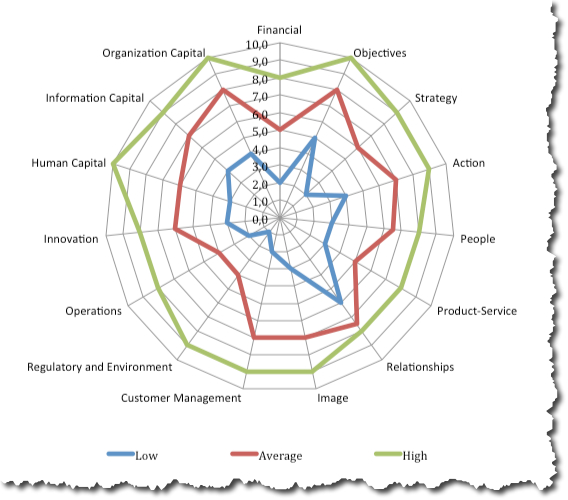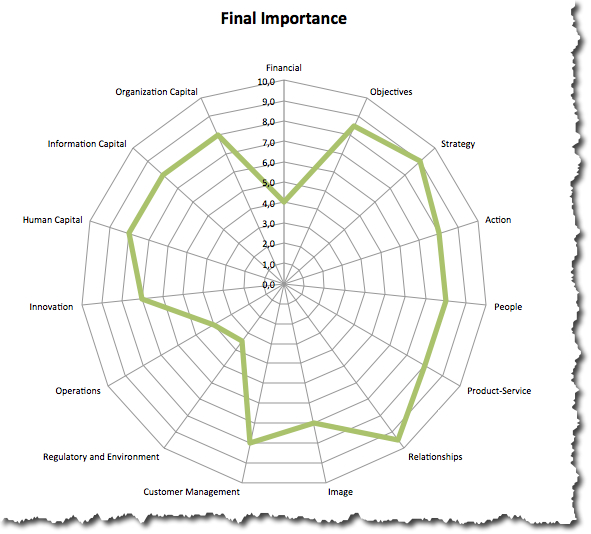Strategy for software Dummies – part 11

Strategy for software Dummies – part 11
The title for this series of posts is inspired by the extensive series of instructional/reference books, which serve as non-intimidating guides for readers new to the various topics covered, or for readers who need a solid brush up. The title doesn’t imply that software CEO’s are Dummies; only that there is a need for a new type of “strategy framework” that produces more than fluff and which can be completed in a very short time.
A recap from post #10.
The ABC company is an Independent Software Vendor planning to go global. They have asked a ValuePerform consultant to help them define an international Go-To-Market plan. The ValuePerform consultant wants to know the current position of the ABC company before any work on future strategies commences. So far the management team of the ABC company has been through a number of exercises revealing that each member of the team has very different perceptions on areas such as the sources of growth, the nature of the Customer Value Proposition and the market situation.
What is important?
Would you agree that the skills required running companies like Apple, Dell and Logica are quite different? I am talking about the skills of the entire organization, not only the skills of the CEO and the management team.
Would you agree that it will take substantial effort and concentration to change the customer value proposition of a company?

The Customer Value Proposition TODAY and in the FUTURE
This is the change the management team of the ABC Company has defined. What should the company do to make these changes happen? Where should the focus be?
The ValuePerform consultant introduced the 15 management areas that any company must weigh against each other. No company can achieve and maintain the black belt in each and all of the 15 disciplines.
Asking the management team to weigh 15 priorities against each other ValuePerform produced the following picture.

What is most and less important?
It is obvious that the individual member of the ABC management team has his own perception of what is important or not. The blue line is the lowest score, the green line is the highest score and the red line is the average.
Based on this graph the ValuePerform consultant now took the ABC management team through each of the 15 management areas.
The critical areas
What are the most critical management areas if your Customer Value Proposition is dominated by Product Leadership?
After discussing this issue the ABC management team concluded that these 3 areas were the critical for achieving and maintaining a position based on Product Leadership:
- Innovation
- The product and service in itself
- An image as leading product provider
Having Customer Intimacy as a second priority the following management areas also needed attention:
- Customer relationships
- Customer management processes
- Image as a “trusted advisor”
Facilitated by the ValuePerform consultant the ABC management team defined the following importance of the 15 management areas:

The relative importance of the 15 management areas
Financial performance: The company is financially very strong, with solid cash reserves, no debt, a large portfolio of long-term maintenance agreements with current customers and a highly loyal customer base. The financial capacity for making new investments and for undertaking projects with “high risk/high earnings potential” is available.
Management Perspective
The importance of the management perspective is accentuated by two co-related issues: The internationalization and the associated need for a change in the Customer Value Proposition. Both issues requires a strong management team, with the ability to set objectives, execute and perform corrective action as needed.
Objectives: The company must grow internationally in the future and this journey is associated with major uncertainty. The ability to set objectives and follow up is considered very important.
Strategy: The strategy of the ABC company must be sharpened. The international market situation is assumed to be much more competitive and thus calls for a more focused strategy. To break into new markets the ABC management team assumes that the product portion of the strategy must be given more attention.
Action: The ability to define and follow up on activities is crucial to ensure that the strategy and plans are executed.
People: With the major changes required it is crucial that competencies and experience is represented in the management team.
The Customer Perspective
The Product/Service: The ABC management team concluded that being successful in new markets (geographies) requires a product which is superior to the local alternatives. However the large market share in the domestic market is caused by the services provided ensuring that customers get full benefit of the product. The ABC management team is convinced that a strong service component is required to be successful in the international markets also.
Relationship: Despite the changes in the Customer Value Proposition, the ABC management team believes that a closed relationship to the individual customer is key to wining and keeping new customers. Combining the relationship aspect with a more product biased strategy calls for standard facilities to customize the product.
Image: The ABC company do not measure brand perception today and thus have no fact based data available. The ABC management team agreed that the image they need to convey in the future is that of a superior product which is highly customizable and one where the services required to help the customers with customization and implementation are available. How to make these services available in new markets was still an open question.
Internal Processes
Customer Management: The ability to manage the customer relationships in all points was considered very important. The processes must be well defined and systems must be available to support the information flow and the decision making process.
Regulatory and Environment: The ABC software solution are only marginally affected by Regulatory and Environment issues. The software must be able to produce certain reports, where the content and format change from time to time. This area is currently in full control and the need for having access to updated report formats are one of the reasons that most customers have and pay for a software maintenance agreement.
Operations: Being a software company, operations is not a big issue. Going forward there needs to be improvement in the area of product planning and management.
Innovation: With a more product driven Customer Value Proposition and international expansion the ABC management team see a need for more innovative behavior. Both the product, the services and the international expansion require new ideas and approaches.
Learning and Growth
“Learning and Growth” includes those initiatives which are required enabling the organization to execute the internal processes and deliver the value to the customers. The ABC management conclude that the substantial changes planned must be reflected in substantial investments in the organization.
Human Capital: The ABC management team concludes that the execution of the strategy requires talented people with very specific skills. HR is considered a high priority area.
Information Capital: Information systems are considered important to support the growth.
Organization Capital: A strong culture and extraordinary leadership is required to execute the ambitions of the ABC management team.
Other posts in this series:
Post #1: Strategy? – oh no, not again!
Post #2: Introducing ValuePerform – a lean approach for strategy analysis and alignment
Post #3: The 6 sources for financial growth
Post #4: Why do management teams disagree?
Post #5: Getting the priorities in place
Post #6: The Customer Value Proposition
Post #7: The Customer Value Proposition TODAY
Post #8: The Customer Value Proposition in the FUTURE
Post #9: The Market Situation
Post #10: ValuePerform and the 15 Management Areas
Post #12: How are we performing?
Post #13: Identifying the important and the urgent issues
Post #14: The Action Plan
Post #15: Why does misalignment occur?
Post #16: The price of management misalignment
Post #17: Avoiding invisible or suppressed misalignment
Post#18: The cost/benefit ratio of ensuring alignment








